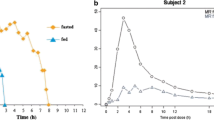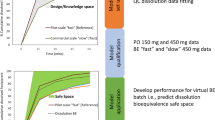Abstract
The method provides an a priori assessment of the maximum allowable flexibility in the rate of release from a prolonged-release formulation. The clinical pharmacokinetic parameters describing the drug candidate are employed to calculate the ranges of rate constants and doses required for the formulation to provide a selected therapeutic duration. For a given patient, there may be an infinite number of combinations of release rate constants and dose sizes which will maintain steady-state plasma drug concentrations within a desired range when the formulation is administered at the selected dosing interval. Computer simulations of steady-state plasma concentrations are employed to establish the ranges for all of the acceptable rate constants and doses for each member of a group. The entire group is then examined to define the range of release rate constants and doses which would provide a useful formulation for every member in the group. Literature values for theophylline clinical pharmacokinetics in children and adults have been employed to illustrate the application of this method. The method is unique in that it provides an entire range of release rates on which to gauge the feasibility for success.
Similar content being viewed by others
REFERENCES
R. E. Notari, M.-Y. Huang, and P. R. Byron. Int. J. Pharm. 1:233–247 (1978).
M. Gibaldi and P. J. McNamara. Int. J. Pharm. 2:167–172 (1979).
P. M. Loughnan, D. S., Sitar, R. I. Ogilvie, A. Eisen, Z. Fox, and A. H. Neims. J. Pediat. 5:874–879 (1976).
H. S. Kaumeier, O. H. Kehrhahn, G. Neugebauer, D. Schuppan, J. A. Schwarz, and A. H. Staib. Arzneim-Forsch 34:92–95 (1984).
R. E. Notari. Biopharmaceutics and Clinical Pharmacokinetics, An Introduction, 4th ed., Marcel Dekker, New York, 1987, pp. 109, 238, 387–392.
G. Levy and R. Koysooko. J. Pediat. 86:789–793 (1976).
E. F. Ellis, R. Koysooko, and G. Levy. Pediatrics 58:542–547 (1976).
P. A. Mitenko and R. I. Ogilvie. Clin. Pharmacol. Ther. 14:509–515 (1973).
J. G. Wagner. Clin. Pharmacokin. 10:432–442 (1985).
F. W. H. M. Merkus and L. Hendeles (eds.). Sustained Release Theophylline: A Biopharmaceutical Challenge to a Clinical Need, Excerpta Medica, Amsterdam, 1983.
P. G. Welling, L. L. Lyons, W. A. Craig, and G. A. Trachta. Clin. Pharmacol. Ther. 17:475–480 (1975).
P. Bolme, M. Eriksson, G. Lonnerholm, and L. Paalzow. Acta Pharmacol. Toxicol. 51:401–406 (1982).
Author information
Authors and Affiliations
Rights and permissions
About this article
Cite this article
Lee, TY., Notari, R.E. Computer-Aided Dosage Form Design. I. Methods for Defining a Long-Acting First-Order Delivery System of Maximum Formulating Flexibility. Pharm Res 4, 311–316 (1987). https://doi.org/10.1023/A:1016445220140
Issue Date:
DOI: https://doi.org/10.1023/A:1016445220140




